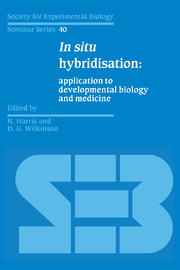Book contents
- Frontmatter
- Contents
- List of contributors
- Preface
- Non-radioisotopic labels for in situ hybridisation histochemistry: a histochemist's view.
- Use of haptenised nucleic acid probes in fluorescent in situ hybridisation
- The use of complementary RNA probes for the identification and localisation of peptide messenger RNA in the diffuse neuroendocrine system
- Contributions of the spatial analysis of gene expression to the study of sea urchin development
- Advantages and limitations of in situ hybridisation as exemplified by the molecular genetic analysis of Drosophila development
- The use of in situ hybridisation to study the localisation of maternal mRNAs during Xenopus oogenesis
- In situ hybridisation in the analysis of genes with potential roles in mouse embryogenesis
- Evolution of algal plastids from eukaryotic endosymbionts
- Localisation of expression of male flower-specific genes from maize by in situ hybridisation
- Tissue preparation techniques for in situ hybridisation studies of storage-protein gene expression during pea seed development
- Investigation of gene expression during plant gametogenesis by in situ hybridisation
- Sexing the human conceptus by in situ hybridisation
- Non-isotopic in situ hybridisation in human pathology
- The demonstration of viral DNA in human tissues by in situ DNA hybridisation
- Index
Index
Published online by Cambridge University Press: 04 August 2010
- Frontmatter
- Contents
- List of contributors
- Preface
- Non-radioisotopic labels for in situ hybridisation histochemistry: a histochemist's view.
- Use of haptenised nucleic acid probes in fluorescent in situ hybridisation
- The use of complementary RNA probes for the identification and localisation of peptide messenger RNA in the diffuse neuroendocrine system
- Contributions of the spatial analysis of gene expression to the study of sea urchin development
- Advantages and limitations of in situ hybridisation as exemplified by the molecular genetic analysis of Drosophila development
- The use of in situ hybridisation to study the localisation of maternal mRNAs during Xenopus oogenesis
- In situ hybridisation in the analysis of genes with potential roles in mouse embryogenesis
- Evolution of algal plastids from eukaryotic endosymbionts
- Localisation of expression of male flower-specific genes from maize by in situ hybridisation
- Tissue preparation techniques for in situ hybridisation studies of storage-protein gene expression during pea seed development
- Investigation of gene expression during plant gametogenesis by in situ hybridisation
- Sexing the human conceptus by in situ hybridisation
- Non-isotopic in situ hybridisation in human pathology
- The demonstration of viral DNA in human tissues by in situ DNA hybridisation
- Index
- Type
- Chapter
- Information
- In Situ HybridisationApplication to Developmental Biology and Medicine, pp. 285 - 288Publisher: Cambridge University PressPrint publication year: 1990

